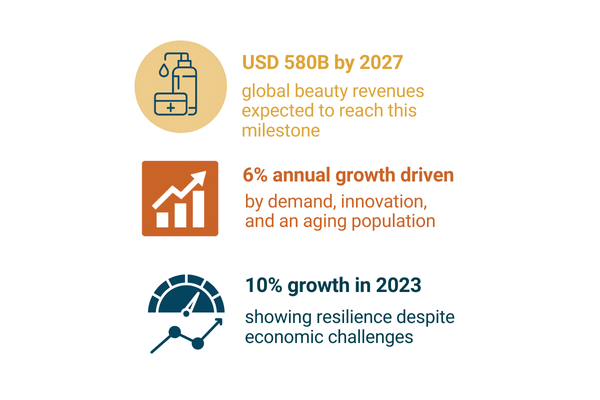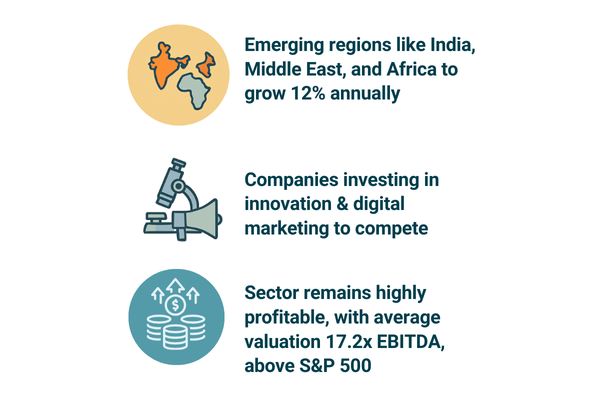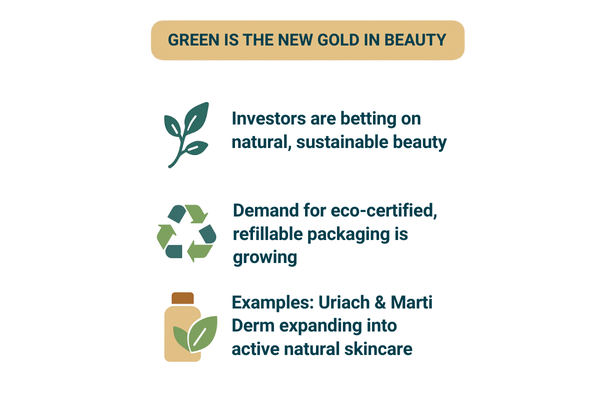Strong Growth in Global Dermatology & Cosmetics Industry
The global Dermatology and Cosmetics industry is demonstrating significant growth potential, despite broader economic headwinds. This resilience is fueling intense mergers and acquisitions (M&A) activity, driven by both strategic industry players and financial investors seeking to capitalize on the market's expansion.
According to a report by Mckinsey and Company, global beauty revenues are projected to reach USD 580 billion by 2027, representing an annual growth of 6%. Data from 2023 indicates revenues reached USD 446 billion, a 10% increase compared to the previous year, underpinned by robust consumer demand. Several factors are driving this expansion, including an aging population, heightened awareness of early disease detection and prevention, and a decreasing age of access to these products, which broadens the target market.

Furthermore, independent brands have emerged, utilizing innovative techniques in online channels and social media, with sustainable products targeting consumers who are increasingly aware of the social and environmental impact of their purchases. Greater competition and the demand for affordable products are contributing to a contraction in margins. Simultaneously, costs are trending upwards due to increasingly stringent regulation and the growing need for investment in innovation and marketing.
Companies need to launch products that adapt to changing consumer preferences and position their own brands and differentiate their products to maintain competitiveness.
Pharmaceutical companies are attracted by synergies in production and marketing and less stringent regulation. This also helps them further penetrate the global Dermatology and Cosmetics market.
M&A Fueled by the Need for Scale and Strategic Synergies
In a highly fragmented sector characterized by economies of scale, major players with the resources to navigate margin compression, undertaking investments in innovation and marketing, and seizing consolidation opportunities offered by market fragmentation are well-positioned for success.
This landscape fosters various types of growth strategies:
-
Vertical integrations aimed at integrating margins
-
Market consolidation movements
-
Entry into new markets, products, or technology

These dynamics are generating intense M&A activity led by both strategic and private equity investment in Dermatology and Cosmetics. In this sense, Spanish companies are playing a leading role in M&A aimed at sector consolidation both nationally and internationally.
A clear example is Puig, which has invested EUR 2.5 billion in M&A transactions since 2011, with the goal of strengthening its competitive position in key markets and accelerating its growth in new categories and emerging markets.
At the same time, there has been a strong influx of international companies entering the Spanish market. One example is Kao, a Japanese personal care and cosmetics company, which last September acquired a stake in Hello Sunday, an innovative Spanish beauty brand specializing in sun protection products. This acquisition supports Kao’s strategy to expand its presence in the European market and offer comprehensive skincare solutions by incorporating a highly sought-after SPF line.
Finally, financial investors accounted for 40% of all deals in the sector in Spain in 2024, drawn by the opportunity to support companies in their growth plans and help consolidate their market position through add-on acquisitions. A recent example is Artá Capital, which last December acquired a majority stake in Viokox, a leading cosmetics company known for producing hair removal products for Mercadona and other retail chains.

Geographic Diversification: A Key to Future Growth
Geographic diversification will be essential in the coming years, especially in emerging markets, which will grow at an average annual rate of 12% until 2027, offering distinct potential for specific categories and price levels. New opportunities and growth avenues will emerge in the Middle East, India, and Africa, where localized strategies can be implemented, resulting in double-digit annual growth until 2027. Traditional markets remain relevant for the Dermatology and Cosmetics sector, but the greatest growth opportunities are in emerging markets.
Valuations Reflect Sector Strength
The Dermatology and Cosmetics sector has historically shown recession-resistant traits, with higher profitability than the S&P 500 index. The index of public companies in the Beauty & Wellness sector traded at an average EBITDA of 10.5x between 2007 and 2009, compared to the S&P 500 average of 9.3x. Similarly, valuations during the COVID-19 period outperformed the S&P 500, with EBITDA multiples of 17.9x between March 2020 and May 2022, compared to 15.8x for the S&P 500. More recently, the multiple remains elevated, with the average being 17.2x, still higher than the S&P 500 average of 14.7x.
Special Focus: Investors Bet on the Green Wave of Natural Cosmetics
Natural cosmetics are rapidly becoming a dominant force in the Beauty industry, driven by increasingly health-conscious and environmentally aware consumers. This shift has not gone unnoticed by strategic and financial investors, who are pouring capital into the sector, betting on its long-term potential.

Examples include the Uriach group's recent acquisition of a French laboratory specializing in natural cosmetics, and Marti Derm's purchase of Caldes de Boí, solidifying its position in the active natural cosmetics space. These deals highlight the growing confidence in this market segment.
The appeal of natural cosmetics lies in their alignment with evolving consumer values. Shoppers are actively seeking products formulated with natural and organic ingredients and are increasingly scrutinizing labels and certifications like Ecocert and Cosmos to ensure quality and transparency.
This demand is pushing brands to innovate, not only in product formulation but also in packaging, with a growing emphasis on biodegradable, recyclable, and refillable options. Companies are also tapping into the power of aromatherapy and phytotherapy, offering consumers a more holistic approach to beauty that encompasses emotional well-being. The result is a dynamic sector that is attracting significant investment and is poised for continued expansion. Natural cosmetics are no longer a niche trend but are becoming a key pillar of the future beauty landscape.


